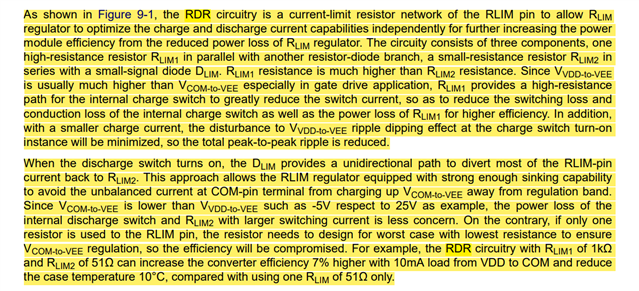Other Parts Discussed in Thread: UCC14141-Q1
Tool/software:
Hi
I would like to know the function of RLIM resistor. How exactly it helps in charge balancing.
Also please explain RLIM in RDR configuration.
This thread has been locked.
If you have a related question, please click the "Ask a related question" button in the top right corner. The newly created question will be automatically linked to this question.
Tool/software:
Hi
I would like to know the function of RLIM resistor. How exactly it helps in charge balancing.
Also please explain RLIM in RDR configuration.
Hi Alphons,
-RLIM function is well explained in Section 7.3.1.2 of FD pg. 18 https://www.ti.com/lit/ds/symlink/ucc14240-q1.pdf?ts=1727395734263&ref_url=https%253A%252F%252Fwww.ti.com%252Fproduct%252FUCC14240-Q1. To summarize, it helps regulating the (COM-VEE) voltage charging and discharging the (COM-VEE) output cap Cout1. Rlim limits the charging current coming from (VDD-VEE) supply, preventing high charge current and decreasing losses for the system.
-Regarding RDR configuration, it is well explained at the end of the Section 9.2.1 of UCC14141-Q1's DS here. Basically, RDR network improves the efficiency of the system decreasing the switching and conduction losses of the charge/discharge network at (COM-VEE) voltage. is better than a single Rlim configuration as it allows a higher resistance across (VDD-VEE) supply when charging Cout1 cap and a lower resistance when discharging Cout1 cap which helps for a faster discharge of the cap and better balancing.

Thank you
Thanks for the reply. I have a question about this setup. Will the compensating network manage the voltage changes across VDD-VEE through the FBVDD pin and VEE-COM using the FBVEE pin? Isn’t adjusting the duty cycle sufficient? Why is this configuration with RLIM used? In an asymmetrical split power supply, there will inherently be a charge imbalance, correct? So, how does it determine which capacitor to charge?
Alphons,
The (COM-VEE) voltage supply regulation is aside of the (VDD-VEE) main voltage supply regulation. (COM-VEE) voltage regulation is like an LDO (linear regulator, although the technique is not quite the same). It takes (VDD-VEE) voltage as a supply and it compared a voltage reference of 2.5V with the voltage at the FBVEE pin, if this voltage is higher, it will discharge Cout1, otherwise if this voltage is lower it will charge Cout1 using (VDD-VEE) supply. RDR helps to improve the efficiency of this regulation process but it is not quite a "compensation network". (VDD-VEE) is different, this is the main voltage supply and is regulated across the compensation network internally to command the on and off of the primary side switches of the half bridge topology. I hope this helps.
Thank you